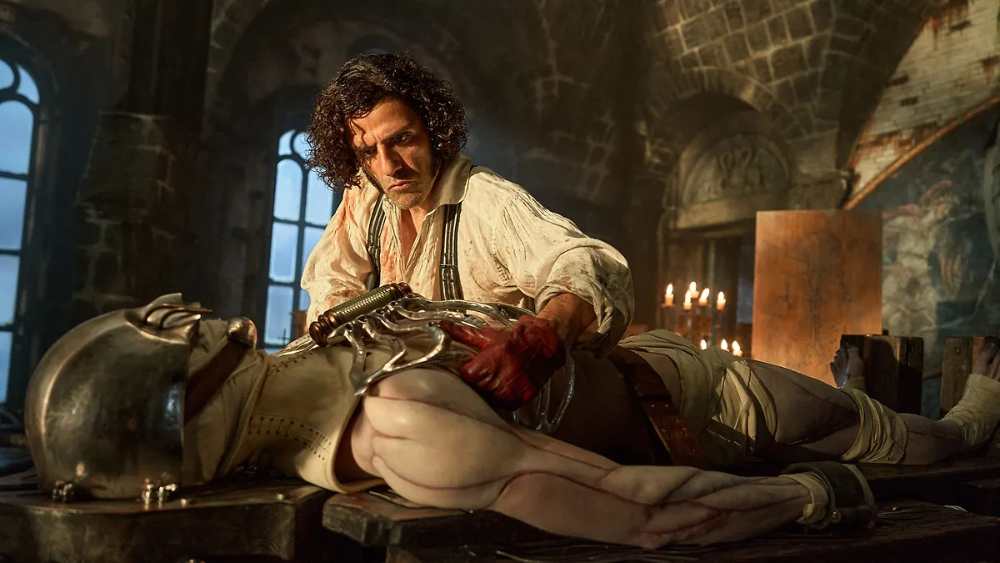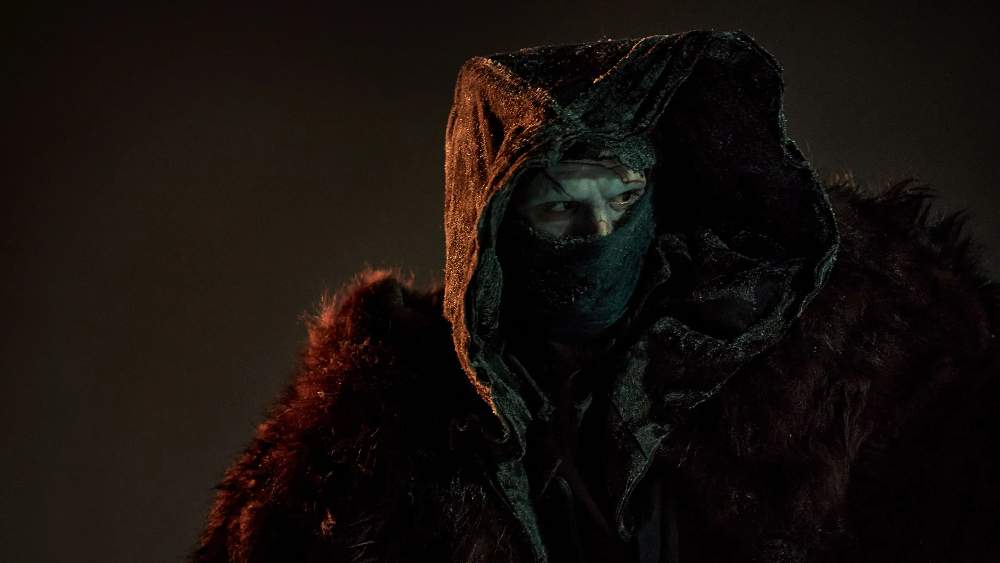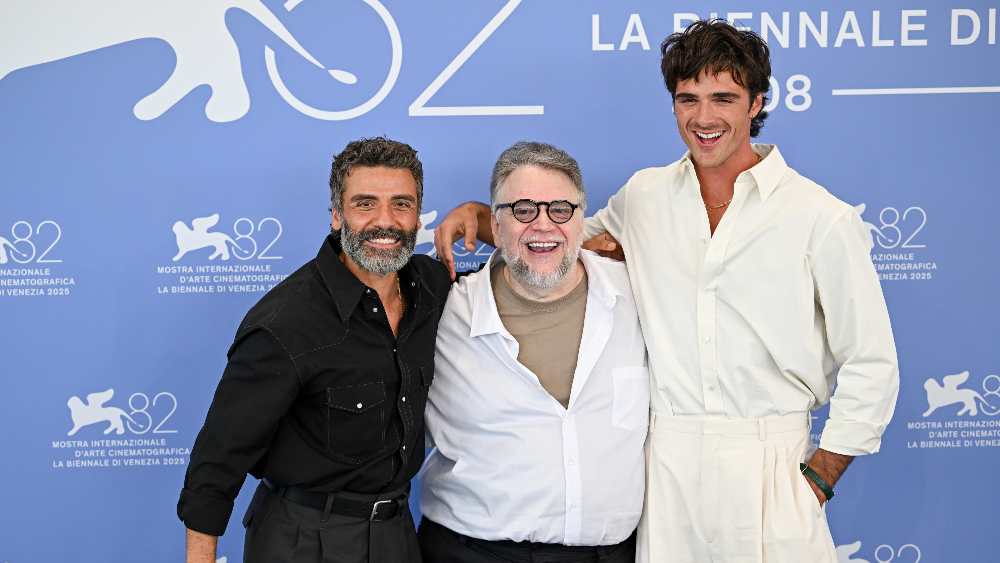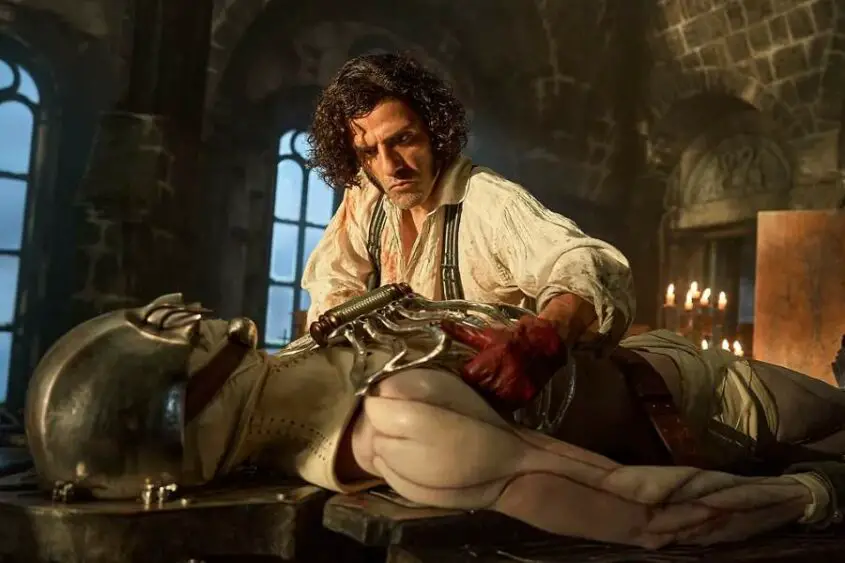There are complex dreams that risk crossing the line into obsession. Primordial Moby Dicks of the unconscious, elusive, childlike fantasies that sink their roots into reality, distorting it until it becomes a warped, alienating nightmare. And then there are dreams that emerge from a shadowy zone between darkness and light, wakefulness and sleep. In dreams, in psychoanalytic terms, we engage in dialogue with our unconscious, welcoming questions we do not even know we wish to ask — as Fox Mulder once suggested in an epic episode of The X-Files.
The protagonist of our reflection is a myth — an ancestral archetype that has silently, eerily returned through the years to haunt the dreams of readers but also, and above all, of viewers. Our second protagonist is an ancient — though not too ancient — medium that turns one hundred and thirty years old in this very year, 2025. A round number, a birthday worth celebrating. And the third is a visionary director like Guillermo del Toro, hopelessly in love with monsters and with his own celluloid creatures, supported by a cast (Oscar Isaac, Jacob Elordi, Mia Goth, Christoph Waltz, Felix Kammerer, David Bradley and many others) who believed in a dream — wild, but not too wild — and poured themselves into making it real, until that sabbath of shadows finally coalesced into form on the silver screen.
It all began, as so many myths do, on a storm-soaked night in June…
The Myth Returns
How certain stories come to be is something their authors — or rather, their creators — always remember. Mary Wollstonecraft Shelley herself recounted the genesis of her novel after a nightmare, in the early hours of June 16, 1816, during a rainy Swiss summer:
I saw the hideous phantasm of a man stretched out, and then, on the working of some powerful engine, show signs of life, and stir with an uneasy, half-vital motion… His success would terrify the artist; he would rush away from his odious handiwork, horror-stricken… and he might sleep (…) He sleeps; but he is awakened; he opens his eyes; behold the horrid thing stands at his bedside, opening his curtains, and looking on him with yellow, watery but speculative eyes.
I opened mine in terror. 1”
And it is already clear from this very moment — when the nightmare has crossed the threshold of the dream and trespassed into reality, scratching its surface and making it bleed with Mary’s copious imagination — that Frankenstein will not only be a pioneering novel of its genre, but a work capable of paving the way for modern sci-fi consciousness, ready to instill horror — and gothic atmosphere — into the most advanced scientific theories of the nineteenth century.
Shelley’s novel is born from the fractures of the psyche, allowing its author to process — through creativity and writing — two bereavements that had deeply marked her: the loss of her first daughter (who died so soon she could not even be given a name, just like the baron’s Creature), and the traumatic death of her mother, after eleven days of long agony. Moreover, according to the fascinating studies by Sandra Gilbert and Susan Gubar2, the “monster” would actually be “a woman in disguise”: its very monstrosity becomes a projection of the cultural anxieties surrounding femininity in Shelley’s own era.
Thus, between Galvani and Darwin, the psyche and the unconscious take shape: the story of Baron Victor Frankenstein and his Creature is born of the irrational — of the sleep of reason that turns shadows into silhouettes projected against a screen, or more simply, into nightmares and monsters. These are creatures we can love, for they are, in the end, nothing more than blank canvases upon which we project the irrational we carry within us; blank canvases in the dark, like the silver screens upon which the illusions of the cinematograph are cast.
Indeed, the monsters of Universal Classics (and beyond) — in films spanning from the 1920s to 1956 — have always been seen as outsiders, ready to subvert an ideal status quo into which they burst to destroy and disrupt it, before that same order is eventually reaffirmed through their defeat. These outsiders embody the quiet, repressed fears that societies project onto anyone deemed different: those persecuted for their beliefs, their sexuality, their gender, their politics, or the physical and mental illnesses they carry. In this sense, the cinematic world becomes a mirror of the “perfect” society it imitates — a society that fights imperfection and rejects “the other,” determined to cast it out in order to preserve its own fragile ideal.
Incredible as it may seem, even in cases where it is difficult to feel immediate empathy for the monstrous protagonists, viewers of Universal films (and not only them — let’s say all horror addicts) ended up — and still end up — feeling a kind of “sympathy” (borrowing from the Greek sympátheia and the English sense of pity, understanding, and solidarity) toward the outcast protagonists: those outsiders in search of a place within a hostile world, claiming their unique identity or the necessity to find themselves at any cost. This paradox — fearing the monster while recognizing oneself in it — is the emotional engine that keeps the myth alive.
Uncanny Doppelgängers

References — semantic, aesthetic, and metaphorical — run through Guillermo del Toro’s Frankenstein from its opening minutes, creating a tension between his private imaginative world (the fantasies and nightmares that shape him as a filmmaker) and the many exterior influences that have seeped into his work over decades.
If Shelley gathered the fragmented anxieties of her time and adapted them to her literary purpose, del Toro recasts the myth through the lens of his own childhood as an outsider, turning Frankenstein into a summation of his cinema — part confession, part artistic manifesto — that extends across his entire career.
The poetics of monsters is, of course, the clearest thread that runs — like a fil rouge — through his body of work: fragile, lost creatures, naïve misfits and outcasts misplaced in a world often populated by cruel men. And this inevitably raises a question: who are, in the end, the real monsters? “The ones in suits and ties, perfectly groomed and well dressed,” answered the director and Jacob Elordi in unison during the Venice Film Festival press conference where the film was presented to the world.
The Creature, the amphibious man from The Shape of Water, Hellboy — all are monsters with golden hearts and childlike souls, set in contrast with the cruelty of Captain Vidal, the deadly Lady Lucille Sharpe, the Mussolini of Pinocchio, Colonel Richard Strickland, and Bradley Cooper’s character in Nightmare Alley. These figures embody the banality of evil that slithers through everyday life, hiding behind respectability and beauty.
In Frankenstein, the double is a recurring theme, expressed through the idea of a reflection that haunts the past until it manifests again in the present — the latter clearly haunted by ghosts and unresolved traumas. Victor projects onto Elizabeth the memory of his deceased and beloved mother; to make this transference literal, del Toro relies on makeup and hairstyling to allow Mia Goth to play both roles, making visible the fault lines that split the baron’s psyche and fuel his revolt against the paternal figure.
The father here represents an oppressive patriarchy — a society that demands conformity at all costs, punishing deviation with ostracism and the stigma of eccentricity. It is a world where genius and madness blur, and where creativity is always suspected of being a step away from mania.

Red is the colour of Victor’s past but also of his present; in fact, it becomes his signature colour — aided by the leather gloves he wears while working on corpses, a dangerous mark of a deviant masterpiece that defies the laws of nature. Perhaps Victor is even more Miltonian than his own Creature, embodying a Romantic defiance against the secular authority of a Father — superior, all-seeing, all-knowing… and all-condemning.
Red as the colour of blood, of passion, of horror that seeps in — seductive, unstoppable — just as it happened in Bram Stoker’s Dracula, directed by Francis Ford Coppola in 1992; and once again, two men who, in defying nature, condemn themselves by their own hands, sealing a (death) pact with eternal unhappiness.
Speaking of colour, the amber tones are a key element in del Toro’s chromatic palette — and in that of his cinematographers. But in Frankenstein, especially throughout the early passages charting Victor’s childhood, the visual imagery resonates vividly with the deliciously 1960s aesthetic of Sergei Parajanov and his masterpiece The Color of Pomegranates. You can also feel an undercurrent of Italian genre cinema from the ’60s and ’70s — a blend of the Dario Argento’s Technicolor nightmare (Suspiria, shot by Luciano Tovoli), the baroque shadows of Mario Bava, and even the gothic flourishes found in Pupi Avati’s work.
All of this is tempered by the swampy greens and dark hues that are indispensable in any self-respecting gothic adaptation, creating chromatic suggestiveness and the right atmosphere. And if we want to identify one last, tenderly cinephilic homage — one that encapsulates Guillermo del Toro’s gentle gaze towards his monstrous creations — here comes a spoiler warning, because we must mention the final scene that closes the film’s monumental narrative: the Creature, finally liberated by the forgiveness granted by its creator (himself dying), watches the sunrise over the ice of the North Pole.
The nightmare is over; the sleep of reason — along with rage, vengeance, and resentment — is swept away by the first light of day, and… “the monster” is moved to tears. The wooden child — just like Pinocchio — has at last become a man, fulfilling his desire for humanity. For this reason, he can surrender to a new and fragile emotion, allowing a single tear to trace his face.
It is an intimate and precious sensitivity that recalls the cinema of Charlie Chaplin, where nonverbal communication becomes a powerful megaphone for the consciences of outsiders — those gazing towards the dawn of a new world, or ready to walk into the melancholic sunset of modern times.
A Creature of Flesh and Celluloid

And finally, we reach the beating heart of the story — a warm organ crossed by electricity and the core of it all: the drama embedded in Shelley’s novel, the needle of the scales that balance the baron’s decisions, and the sole measure that forces him to confront the weight of his own actions.
Within free will, within that blurred boundary between good and evil, darkness and clarity, night and day, light and shadow — lies the Creature. In the voracious (and bulimic) pop imagination, it has finally been renamed Frankenstein, stealing the name of its own creator to better sell Halloween costumes and candy stamped with its square and bolted head.
In the molten passage from paper to the silver screen, many — among directors, screenwriters, and members of countless crews — have transgressed the original material, each returning with their own version of the grotesque baron’s mad experiments, perhaps indulging the disturbing nightmares of their own subconscious.
Del Toro, however, breaks with the iconographic tradition of the seventh art, returning to the myth’s original matrix. Despite the liberties he takes in adapting the novel — and the personal imprint with which he handles it, as though exorcising evident fragments of himself — he goes back to the source to conceive the Creature’s appearance. In his hyperkinetic creativity, it becomes a broken and traumatized alabaster statue, an unfinished and flawed masterpiece. Just as it must have appeared to its creator, first in love with himself and his own omnipotence, and finally terrified by the tangible consequences of his hybris. He played God, usurped the Almighty, inverting the natural cycle of life and death — he, a man, who decided independently to give life. And the monstrous result stands right before his eyes, destined to haunt him as long as he breathes.
Just like the entire dream of adapting Frankenstein for the screen, the choice of the right actor to embody the Creature proved to be a true challenge for Guillermo del Toro. His first choice had been the English actor Andrew Garfield, who eventually dropped out due to scheduling conflicts. It was only then that Jacob Elordi — a young and rising Australian star — appeared on the director’s path, seeking a way out of the comfort zone of Hollywood teen movies: from the most mainstream, commercial productions that made him a household name among screaming fans (The Kissing Booth trilogy by Netflix), to the critical success of Euphoria, Sam Levinson’s teen drama that launched (and confirmed) many of Hollywood’s new talents.

Filmmakers like Levinson, Adrian Lyne, Paul Schrader (Oh, Canada), Emerald Fennell (Saltburn), and Sofia Coppola (Priscilla) helped guide Elordi out of the shadow of mere objectification. But it is with del Toro that this process reaches its apex. The director’s choice is to destroy the statue, to shatter the image, to deconstruct it into countless physical fragments — and then reassemble it into a body that is unsettling, menacing, literally uncanny. The adjective is used here in its Freudian sense, describing when aspects of our reality suddenly assume unfamiliar contours within the dream sphere, disturbing us and leaving behind a sense of discomfort and unease.
The Creature’s extreme realism — “human, all too human,” to the point of becoming repulsive in its creator’s eyes — evokes profound horror and revulsion (growing scar by scar) in everyone around him, except for Elizabeth, who truly “sees” him, beyond appearances. A similar mechanism underlies the uncanny valley3 phenomenon, now common in the world of AI and new technologies, when an artificial intelligence — human, too human — is recognized by our brain as real but still instinctively rejected, not accepted as such.
Del Toro’s Creature is thus a patchwork of the bodies of soldiers killed during the Crimean War. In one already-iconic scene — with echoes of Lucio Fulci — the baron strides exuberantly among heaps of corpses and dismembered limbs in his laboratory, working on his ultimate sartorial masterpiece: the perfect man who will allow him to proclaim, “I have defeated death — it could work.” A deliberate reference to Young Frankenstein by Mel Brooks? Yes — because there is room even for that parodic version of the story in del Toro’s Frankenstein. Indeed, this Netflix production is the heir of all the films that came before it. A compendium in images, an entire narrative universe of celluloid — more or less accurate, more or less horrific, more or less serious, dramatic or humorous; more auteur, or leaning towards parody.
The monster as a metaphor for a complex, layered inner world — of unconscious and hidden fears. The monster as the symbol of an entire creative production dedicated, as in del Toro’s case, to exploring them through ever-shifting nuances, reinterpreting them through genre-blending, and allowing himself to be influenced by comics, myth, fairy-tale archetypes, and the horrors of history. The new Frankenstein is the manifesto film of an entire filmography. A director who has finally reached his Moby Dick, that spectral white whale that has always haunted him, transforming the unfilmable — the impossible — into a tangible result, a cinematic work of flesh and celluloid (even if, needless to say, we now live in the digital age).
The use of AI, CGI, and green screen was reduced to a minimum on set: everything was painstakingly reconstructed down to the smallest detail, and even the Creature’s makeup is the result of endless prosthetic sessions — ten hours each — meant to strip Elordi of the mask Hollywood had sewn onto him as the “next heartthrob.” A role society had assigned him but which clearly fits him poorly, judging by his recent film choices.
(…) I could put every sort of part of myself into, you know, from everything that’s unconscious from the moment that I was born to being here with you today, all of it is in that character. And in so many ways, the Creature that’s on screen in this movie is the sort of purest form of myself. He’s more me than I am. And I think as a performer, that’s… If you can achieve that in something that you think you’re going to get lost in, if you can find yourself in a character that you plan to get lost in, I think that’s a really beautiful thing that can happen. And that’s what happened to me.
Elordi mused at the Venice International Film Festival.

The final result, born from Guillermo del Toro’s love (for “monsters”) and Elordi’s dedication to the cause — to the point of disappearing into the role — gives life to a tormented figure in search of himself, of a fragmented and deconstructed identity (literally piece by piece), who tries to put himself back together simply by living. He discovers himself in the mirror of his relationships with others: the blind man who welcomes him and opens the doors of knowledge through books; Elizabeth, who immediately senses a sublime shared spark in the Creature’s eyes — both outsiders at the margins of society; a harsh, feral world cruel in its humanity but not in its nature (pure and nurturing); and even in the bond with his reluctant creator/father, Victor.
A naïve purity trapped in a monumental body — an alabaster statue whose tragic, kintsugi-like wounds are not filled with gold, but with del Toro’s creativity, who adds a detail not present in Shelley’s novel: the power of regeneration, a trait that condemns the “monster” to the heart-wrenching drama of eternity.
And it is through this seemingly innocuous narrative twist that del Toro’s Frankenstein finds yet another deeply personal key, one that flows through the director’s own life experience, imagination, and creative sensitivity. The same energy that has always infused his films (and inspired his cast). Like postmodern cinema itself, the Creature is a body of flesh — and celluloid — in search of its identity, condemned to eternity and to the persistence of memory, akin to the dance of shadows on the silver screen.
The same vibration, after all, that ran through Francis Ford Coppola’s Bram Stoker’s Dracula. In that film, the New York–born director deliberately inserted the cinematograph into the screenplay as a distinctive detail — a way of preserving, in the eternity of memory, the loss of his son Gian Carlo in a boating accident. Consumed by grief, Coppola found the only way to exorcise it: by telling a gothic literary tale suspended between (black) romanticism and the drama of eternity, but also the vampires’ curse — to watch time pass helplessly, striving to hold on to those they love.
That spell which only cinema can truly reproduce — a moving illusion, a shadow play ready to repeat itself infinitely, transmitting a memory, telling stories even when the only things moving on screen are ghosts.
- “Frankenstein – The original 1818 text, third edition”, Mary Shelley. Edited by D.L Macdonald and Kathleen Scherf, Broadview editions, Canada, 2012. ↩︎
- Ibidem. ↩︎
- The uncanny valley (or “valley of eeriness”) is a concept introduced in 1970 by the Japanese robotics professor Masahiro Mori, according to which familiarity and affection toward a robot increase — but are abruptly interrupted — when its almost perfect realism provokes a sense of repulsion and unease, mainly due to its small imperfections ↩︎
By Ludovica Ottaviani
Ludovica Ottaviani is an Italian film and music critic, writer, and radio host with over fifteen years of experience in cinema and cultural journalism. She contributes to Rai Uno’s Cinematografo, hosts the podcast Daiquiri Corner and the radio segment Musica per Organi Caldi, and focuses on auteur cinema, transnational genre studies, and the poetics of myth and monstrosity. She is the author of the short-story collection Sotto il Sole della KaliFormia (Edizioni Haiku, 2021). Instagram: @louadelson

